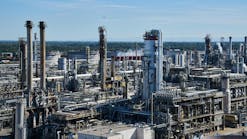By OGJ editors
HOUSTON, July 27 -- Zodiac Exploration Inc., Calgary, has upgraded the Eocene Kreyenhagen formation to a primary objective based on further analysis of engineering and geological data from its 4-9 vertical test well in Kings County, Calif.
As previously reported, following a 24-ton frac stimulation over a 30-ft siltstone interval in the Kreyenhagen formation, the 4-9 well averaged a flow of 24 b/d of 29° gravity oil for 9 days before being shut-in for pressure build-up.
The pressure test analysis indicated significant skin (formation) damage of approximately +13, which the company believes can be addressed by optimizing stimulation procedures in future wells. The Inflow Performance Relationship (IPR) derived from the well test analysis demonstrated that a rate of 120 b/d could potentially be achieved with 60% pressure drawdown and elimination of formation damage.
The reservoir is overpressured with 12,800 psi reservoir pressure and a gradient of 0.9 psi/ft. Porosity and permeability values derived from well log analysis indicate effective siltstone porosity of 10-13% with permeability of 0.4-3.0 md.
Murray Rodgers, Zodiac president and chief executive officer, said, “To put these results into perspective, this test rate was generated from the stimulation of a 30-ft siltstone interval, while we have identified a total of 150 ft of siltstone in this formation in the 4-9 wellbore. It is significant that our geoscience team has also identified up to 500 ft of siltstone on other portions of company acreage.
“We have now demonstrated that we can successfully place a hydraulic fracture into the Kreyenhagen siltstone which greatly enhances our ability to access the existing natural fractures present in the reservoir. As we improve our completion techniques, an increase in production performance can be achieved. We believe we have identified a major light oil resource play; however, additional testing and evaluation will be required to confirm the potential of the Kreyenhagen formation.”
The shales of the Kreyenhagen formation in the 4-9 well exhibit specific geological characteristics similar to and in some cases superior to other successful source rock plays in North America, Zodiac noted. Extensive analysis of well logs, drill cuttings, and core data indicate high oil-prone total organic carbon of up to 5.75% and sufficient maturity to assist in confirming the company’s view that the Kreyenhagen shales are presently generating oil on company lands.
The analysis indicates high shale porosity and permeability, averaging 5.7% and .06 md, respectively. A pervasive natural fracture system that may enhance these reservoir parameters has also been identified.
Substantial gross formation thickness including both siltstones and shales range from 800 to more than 1,000 ft across company lands. While not expected to be prospective on all of the company’s lands, the Kreyenhagen formation is present on the entire 86,000 net acres controlled by the company. For comparison, net siltstone reservoir thicknesses in the Bakken formation in North Dakota and Saskatchewan is 20-30 ft on average.
The company also announces that in addition to the ongoing completion and testing program for the 4-9 well, Zodiac’s 1-10 appraisal well has reached a total depth of 13,515 ft and the company is preparing to set intermediate casing. The 1-10 well reached this depth in 36 days versus 57 days to a similar depth in the 4-9 well.
The 1-10 well is 1 mile east of the 4-9 well and is planned as the company’s first horizontal well. The 4-9 well test results, combined with geological and geophysical data gathered to date, will determine the placement of the horizontal leg in the 1-10 well.
A large independent oil and gas producer has elected to participate in the drilling of the 1-10 well with a 20% working interest. Results of the Lower Vaqueros completion in the 4-9 well are still being analyzed, and Zodiac expects to begin testing the Oligocene Whepley formation in early August.

